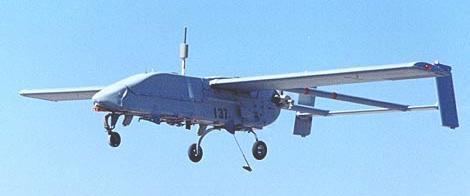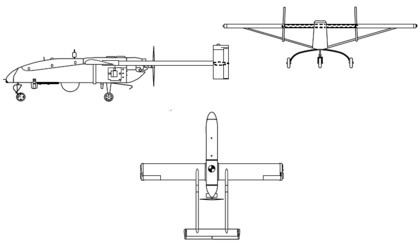Top speed 200 km/h Weight 177.8 kg Length 4 m | Range 185 km Wingspan 5.2 m Engine type Reciprocating engine | |
 | ||
Manufacturers Israel Aerospace Industries, AAI Corporation Similar IAI RQ-5 Hunter, General Atomics MQ-1 Predator, Lockheed Martin RQ-3 DarkStar, AeroVironment RQ-14 Dragon Eye | ||
Close look at aai rq 2 pioneer used in iraq as reconnaissance uav
The AAI RQ-2 Pioneer is an unmanned aerial vehicle (UAV) that had been utilized by the United States Navy, Marine Corps, and Army, and deployed at sea and on land from 1986 until 2007. Initially tested aboard USS Iowa, the RQ-2 Pioneer was placed aboard Iowa-class battleships to provide gunnery spotting, its mission evolving into reconnaissance and surveillance, primarily for amphibious forces.
Contents
- Close look at aai rq 2 pioneer used in iraq as reconnaissance uav
- Operation
- Specifications
- Operators
- References

It was developed jointly by AAI Corporation and Israel Aircraft Industries. The program grew out of successful testing and field operation of the Tadiran Mastiff UAV by the American and Israeli militaries.

Essentially, the Pioneer is an upgraded Tadiran Mastiff which was re-engined to accommodate a greater payload by request of the US Navy. To accomplish this, the original "Limbach" two-cylinder two-stroke engine was replaced with a Fichtel & Sachs two-cylinder two-stroke. The Limbach motor utilized a 71 cm propeller from Propeller Engineering and Duplicating, Inc. of San Clemente, California. The newer, more powerful Fichtel & Sachs motor was outfitted with a 74 cm propeller (which spins in the opposite direction) from the Sensenich Propeller Manufacturing Company of Lancaster, Pennsylvania.

Operation

Launched by rocket assist (shipboard), by catapult, or from a runway, the Pioneer recovers into a net (shipboard) or with arresting gear after flying up to five hours with a 75-pound (34 kg) payload. It flies day or night missions with a gimbaled EO/IR sensor, relaying analog video in real time via a C-band line-of-sight (LOS) data link. Since 1991, Pioneer has flown reconnaissance missions during the Persian Gulf, Somalia (UNOSOM II), Bosnia, Kosovo and Iraq conflicts. In 2005, the Navy operated two Pioneer systems (one for training) and the Marines operated two, each with five or more aircraft. It is also operated by Israel and the Republic of Singapore Air Force. In 2007 Pioneer was retired by the US Navy and was replaced by the Shadow UAV.

Internationally, Pioneer drones are perhaps most remembered for their role in the 1991 Gulf War, when a Pioneer launched by the Iowa-class battleship USS Wisconsin (BB-64) observed Iraqi troops on Failaka Island surrendering shortly after USS Missouri's attack on their trenchlines. When navy officials offered to transfer a Pioneer to the Smithsonian Institution, curators at the National Air and Space Museum specifically asked for the UAV that Iraqi troops surrendered to during the Gulf War.
The "R" is the Department of Defense designation for reconnaissance; "Q" means unmanned aircraft system. The "2" refers to its being the second of a series of purpose-built unmanned reconnaissance aircraft systems.
